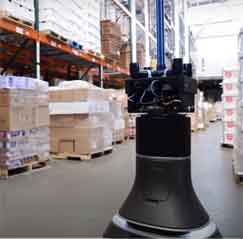During the coronavirus crisis, there have been many reports of warehouses and factories shutting down for “deep cleaning” after one or more workers became sick with the virus.
That of course is a very expensive proposition, both in terms of shutting down the operation and the cleaning effort itself – an effort that might put cleaning employees at risk as well.
Supply Chain Digest Says... |
|
|
Of course, in many cases the sick workers may have contracted the virus outside the facility, but it's usually impossible to know. It would certainly be better to minimize the chance of coming in contact with the virus internally, and /or achieving the disinfecting of a facility or area as quickly and economically as possible.
Well, a team from MIT's Computer Science and Artificial Intelligence Laboratory (CSAIL), in collaboration with Ava Robotics, have come up with a way to do the disinfecting with a machine and ultraviolet light.
They MIT researchers say the machine disinfects surfaces and - critically - neutralizes aerosolized forms of the coronavirus. That seems ever more important given recent reports that the virus stays airborne for longer periods than believed previously.
The technology was piloted by MIT and Ava at a facility of the Greater Boston Food Bank, which operates a 4000-square foot warehouse to support its mission.
The MIT technology uses a custom UV-C light fixture designed at CSAIL that is integrated with Ava Robotics' mobile robot base. The results were encouraging enough that researchers say that the approach could be useful for autonomous UV disinfection not only in a warehouse but also other environments, such as factories, restaurants, and supermarkets.
The MIT News web site reports that UV-C light has proven to be effective at killing viruses and bacteria on surfaces and aerosols. However, it is unsafe for humans to be exposed to it.
The Ava's telepresence robot doesn't require any human supervision. Instead of the telepresence top, the team put in a UV-C array for disinfecting surfaces. Technically, the array uses short-wavelength ultraviolet light to kill microorganisms and disrupt their DNA in a process called ultraviolet germicidal irradiation.
The complete robot system is capable of mapping a facility space, such as the food bank warehouse. Using something called a dosimeter, the researchers were able to confirm that the robot was delivering the expected dosage of UV-C light predicted by its theoretical model.
During the test at the warehouse, the robot was able to drive by the pallets and storage aisles at a speed of roughly 0.22 miles per hour. At this speed, the robot could cover a 4,000-square-foot space in GBFB's warehouse in just half an hour.
The UV-C dosage delivered during this time should neutralize approximately 90% of coronaviruses on surfaces. For many surfaces, the dose will be higher than in this test, resulting in more of the virus neutralized.
The basic ultraviolet light approach for disinfecting has been used for years in hospitals and medical settings to sterilize patient rooms and stop the spread of dangerous microorganisms.
(See More Below)
|
CATEGORY SPONSOR: SOFTEON |
|
|
| |
|
|
 While it's most effective with direct "line of sight" it can get to nooks and crannies as the light bounces off surfaces and onto other surfaces. While it's most effective with direct "line of sight" it can get to nooks and crannies as the light bounces off surfaces and onto other surfaces.
In the test the system focused heavily on pallets of goods lined for shipping to partners the next day. The robots does passes up and down the pallets to reduce the chance of the virus spreading out into the community.
A unique challenge is that the shipping area is constantly changing, so each night, the robot encounters a slightly new environment. When the robot is deployed, it doesn't necessarily know which of the staging aisles will be occupied, or how full each aisle might be. Therefore, the team notes that they need to teach the robot to differentiate between the occupied and unoccupied aisles, so it can change its planned path accordingly.
The design is in its early stages, and many improvements are already planned, such as improvement in coordinating teams of UV-C robots to work together.
It is unclear when the system will be ready for commercialization, but we're sure if you are interested main inventor Daniela Rus, CSAIL director, would be happy to talk with you.
What do you think of this MIT robot? Let us know your thoughts at the Feedback section below.
|